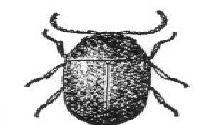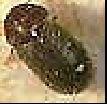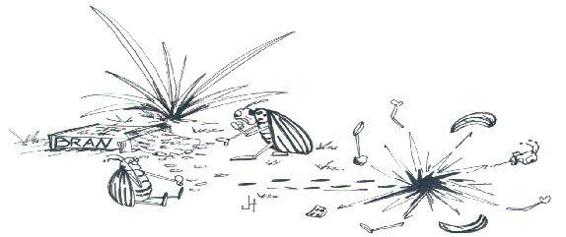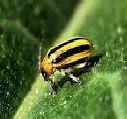Natural Solutions to Things That Bug You (45 page)
Read Natural Solutions to Things That Bug You Online
Authors: Myles Bader
It is 1/10 to 1/8 inch long and the antennae are serrate (the side edge of each antennal segment is pointed like a saw tooth). The wing coverings are smooth without longitudinal grooves. They can be found throughout the year, but seems to be more common in the fall and winter months.
The eggs are white, oval and too small to be seen with the naked eye. The cigarette beetle larvae are white and grub-like with long hairs covering the bodies giving them a fuzzy appearance. When full grown they are about 1/8-inch long. Larvae spin themselves into a cocoon prior to becoming pupae.
Adults lay their eggs on the food material so the larvae can eat. Adults live about two to four weeks. The females lay up to 100 eggs; the development time from egg to adult is six to eight weeks and there are three to six generations every year. The minimum development temperature is 65
F.

Cigarette beetles will infest a wide variety of food products such as:
Aniseed, bamboo, beans, biscuits, cassava, chickpeas, cigars, cigarettes, cocoa beans, coffee beans, copra, coriander, cottonseed (before and after harvest), cottonseed meal, cumin, dates, dog food, dried banana, dried cabbage, dried carrot, dried fruits, drugs, flax tow, flour, ginger, grain and most herbs.
The cigarette beetle can be controlled without the use of dangerous pesticides. The first step in control of the cigarette beetle is to find the source of the infestation, which means inspecting all of the dried foods in the infested cabinets or drawers. Once the infestation is found, it should be destroyed and the cabinets and drawers cleaned with a vacuum cleaner (then throw the cleaner bag away).
 Glass jars and plastic containers with air tight covers effectively keep food insect-free and are the best to use. Susceptible food items need to be tightly contained or stored in the refrigerator or freezer, or be consumed within two to three weeks of purchase.
Glass jars and plastic containers with air tight covers effectively keep food insect-free and are the best to use. Susceptible food items need to be tightly contained or stored in the refrigerator or freezer, or be consumed within two to three weeks of purchase.
COLORADO POTATO BEETLE
Identification:
 This is a round ½ inch yellow beetle with black stripes down its back and a reddish head that loves to eat potato leaves. They lay yellow-orange eggs on the underneath side of the leaves. The eggs will hatch in 5-9 days. The larvae are fat and red with black spots and black heads. They chew on the leaves, skeletonizing them and several generations can emerge every year.
This is a round ½ inch yellow beetle with black stripes down its back and a reddish head that loves to eat potato leaves. They lay yellow-orange eggs on the underneath side of the leaves. The eggs will hatch in 5-9 days. The larvae are fat and red with black spots and black heads. They chew on the leaves, skeletonizing them and several generations can emerge every year.
General Information:
The adults hibernate in the soil over the winter. In the last few years this beetle has become more prevalent. If you find black excrement on the leaves it may be this beetle.
This beetle consumes potatoes, tomatoes, eggplant, cabbage and peppers. You may also find them munching on your petunias. If you plant Sequoia potatoes they will not eat them.
BENNIES TO THE RESCUE
Beneficial insects are one of the best methods of eradication of these pests. Use
Edovum puttleri
, ladybugs or lacewings. The ladybugs love to feast on their eggs and are the best one to eliminate the beetles. They don’t like green beans and if you plant them with the potatoes they will probably leave the area alone. Bt will also work very well against these insects.
KILLING THE LARVAE
Using a soap and lime spray will kill off the larvae by dehydration and a garlic and pepper juice spray will repel them and send them packing.
CRUSH THOSE EGGS
In early spring the beetles lay their eggs on the underneath side of the potato leaves. However, keep checking the underneath sides of the leaves regularly for eggs and remove them since this is one of the best methods of controlling the beetle.
NATURAL REPELLENTS
There are a number of plants that will repel these bugs if they are planted near the plants that they consume. These include marigolds, garlic, snap peas, onions, flax, catnip, coriander, nasturtiums, tansy, dead nettle and horseradish.
EXPLODING BEETLES
If you sprinkle wheat bran that has been well moistened around your plants the beetles will eat the bran before they eat your plants. They will then swell up and literally explode. The beetle’s cuticle will actually give under the bloating pressure.



DANGER, EXPLODING BEETLES
GIVE THEM A CUP OF TEA OR A SHOT OF SALTS
You can prepare a tea made from basil or cedar chips and place it in a sprayer. This works very well in keeping the beetles at bay. You can also add 2 tablespoons of Epsom salts to a gallon of water and spray to protect your plants.
GET OUT THE SOAP BUCKET
If you know that the bugs are present, walk along next to the plants with a bucket of soapy water and lightly shake the plants allowing the bugs to fall off into the bucket. The slightest disturbance will cause the beetles to leave the plant. However, if you see eggs on the underneath side of the leaves they will have to be crushed.
CUCUMBER BEETLE
Identification:
 These are green and yellow beetles with either three black stripes or 12 black spots on their back.
These are green and yellow beetles with either three black stripes or 12 black spots on their back.

General Information:
The biggest problem usually occurs early in the season when their larvae chew through the stalks of a member of the squash family. They prefer cucumbers, acorn squash, melons of all types and summer squash. Usually two generations appear every year. They are also known as the southern corn rootworm. They will spend their winter in garden debris, weeds or under logs. There is a chemical in cucumbers called
“curcurbitacin”
that attract these insects. It is a bitter essence that they love.
